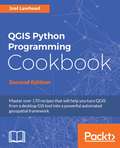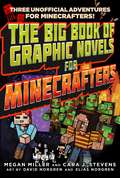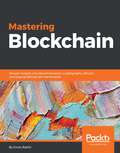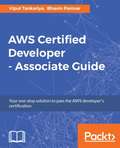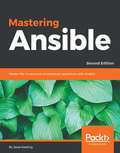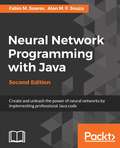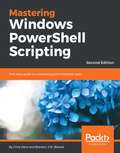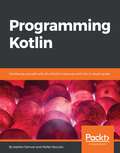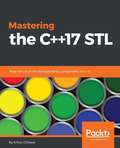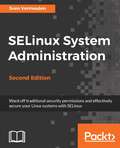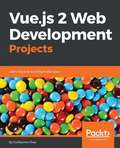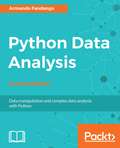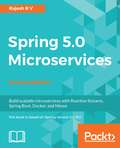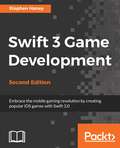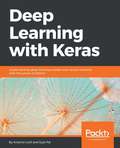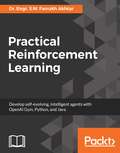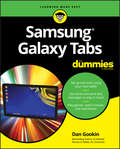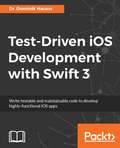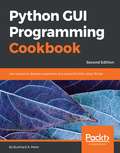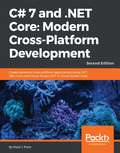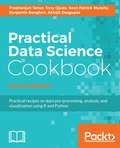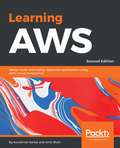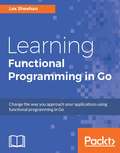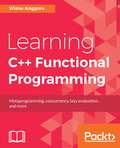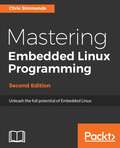- Table View
- List View
QGIS Python Programming Cookbook - Second Edition
by Joel LawheadMaster over 170 recipes that will help you turn QGIS from a desktop GIS tool into a powerful automated geospatial framework About This Book • Delve into the undocumented features of the QGIS API • Get a set of user-friendly recipes that can automate entire geospatial workflows by connecting Python GIS building blocks into comprehensive processes • This book has a complete code upgrade to QGIS 2.18 and 30 new, valuable recipes Who This Book Is For This book is for geospatial analysts who want to learn more about automating everyday GIS tasks as well as programmers responsible for building GIS applications. The short, reusable recipes make concepts easy to understand and combine so you can build larger applications that are easy to maintain. What You Will Learn • Use Python and QGIS to produce captivating GIS visualizations and build complex map layouts • Find out how to effectively use the poorly-documented and undocumented features of the QGIS Python API • Automate entire geospatial workflows by connecting Python GIS building blocks into comprehensive processes • Create, import, and edit geospatial data on disk or in-memory • Change QGIS settings programmatically to control default behavior • Automatically generate PDF map books • Build dynamic forms for field input In Detail QGIS is a desktop geographic information system that facilitates data viewing, editing, and analysis. Paired with the most efficient scripting language—Python, we can write effective scripts that extend the core functionality of QGIS. Based on version QGIS 2.18, this book will teach you how to write Python code that works with spatial data to automate geoprocessing tasks in QGIS. It will cover topics such as querying and editing vector data and using raster data. You will also learn to create, edit, and optimize a vector layer for faster queries, reproject a vector layer, reduce the number of vertices in a vector layer without losing critical data, and convert a raster to a vector. Following this, you will work through recipes that will help you compose static maps, create heavily customized maps, and add specialized labels and annotations. As well as this, we'll also share a few tips and tricks based on different aspects of QGIS. Style and approach This book follows a recipe-based problem-solution approach to address and dispel challenges faced when implementing and using QGIS on a regular basis.
The Big Book of Graphic Novels for Minecrafters: Three Unofficial Adventures
by Megan Miller Cara StevensPhoenix, a young miner girl, has never known her parents. She has always dreamed of something greater, of seeing the world outside her village and the magical forest that lies just beyond the walls. One day she takes the risk—just a quick hop over the walls—but her forbidden trip changes the course of her life. Thrust into a world of zombies, creepers, witches, and magical monks, Phoenix finds the adventure she craved, but will she find the bravery she needs to save not only her village but the entire Overworld? Containing The Quest for the Golden Apple, Revenge of the Zombie Monks, and The Ender Eye Prophecy, The Big Book of Graphic Novels for Minecrafters will enchant readers of all ages who love playing Minecraft and love stories full of action, adventure, and bravery. <P><P> <i>Advisory: Bookshare has learned that this book offers only partial accessibility. We have kept it in the collection because it is useful for some of our members. Benetech is actively working on projects to improve accessibility issues such as these.</i>
Mastering Blockchain
by Imran BashirDistributed ledgers, decentralization and smart contracts explained About This Book • Get to grips with the underlying technical principles and implementations of blockchain. • Build powerful applications using Ethereum to secure transactions and create smart contracts. • Explore cryptography, mine cryptocurrencies, and solve scalability issues with this comprehensive guide. Who This Book Is For This book appeals to those who wish to build fast, highly secure, transactional applications. This book is for those who are familiar with the concept of blockchain and are comfortable with a programming language. What You Will Learn • Master the theoretical and technical foundations of blockchain technology • Fully comprehend the concept of decentralization, its impact and relationship with blockchain technology • Experience how cryptography is used to secure data with practical examples • Grasp the inner workings of blockchain and relevant mechanisms behind Bitcoin and alternative cryptocurrencies • Understand theoretical foundations of smart contracts • Identify and examine applications of blockchain technology outside of currencies • Investigate alternate blockchain solutions including Hyperledger, Corda, and many more • Explore research topics and future scope of blockchain technology In Detail Blockchain is a distributed database that enables permanent, transparent, and secure storage of data. The blockchain technology is the backbone of cryptocurrency – in fact, it's the shared public ledger upon which the entire Bitcoin network relies – and it's gaining popularity with people who work in finance, government, and the arts. Blockhchain technology uses cryptography to keep data secure. This book gives a detailed description of this leading technology and its implementation in the real world. This book begins with the technical foundations of blockchain, teaching you the fundamentals of cryptography and how it keeps data secure. You will learn about the mechanisms behind cryptocurrencies and how to develop applications using Ethereum, a decentralized virtual machine. You will explore different blockchain solutions and get an exclusive preview into Hyperledger, an upcoming blockchain solution from IBM and the Linux Foundation. You will also be shown how to implement blockchain beyond currencies, scability with blockchain, and the future scope of this fascinating and powerful technology. Style and approach This comprehensive guide allows you to build smart blockchain applications and explore the power of this database. The book will let you quickly brush up on the basics of the blockchain database, followed by advanced implementations of blockchain in currency, smart contracts, decentralization, and so on.
AWS Certified Developer-Associate Guide
by Vipul TankariyaWith rapid adaptation of the cloud platform, the need for cloud certification has also increased. This is your one stop solution and will help you transform yourself from zero to certified. This guide will help you gain technical expertise in the AWS platform and help you start working with various AWS Services.
Mastering Ansible - Second Edition
by Jesse KeatingMaster the ins and outs of advanced operations with Ansible About This Book • Learn how to extend Ansible with custom modules, plugins, and inventory sources • Utilize advanced Ansible features to orchestrate rolling updates with little to no service disruptions • An up-to-date book that brings to light the newly added features in Ansible 2.x Who This Book Is For This book is for Ansible developers and operators who have an understanding of the core elements and applications but are now looking to enhance their skills in applying automation using Ansible. What You Will Learn • Gain an in-depth understanding of how Ansible works under the covers • Fully automate the Ansible playbook executions with encrypted data • Access and manipulate variable data within playbooks • Use Blocks to construct failure recovery or cleanup • Explore the Playbook debugger and Ansible Console • Troubleshoot unexpected behavior effectively • Work with cloud infrastructure providers and container systems • Develop custom modules, plugins, and dynamic inventory sources In Detail This book provides you with the knowledge you need to understand how Ansible 2.1 works at a fundamental level and leverage its advanced capabilities. You'll learn how to encrypt Ansible content at rest and decrypt data at runtime. You will master the advanced features and capabilities required to tackle the complex automation challenges of today and beyond. You will gain detailed knowledge of Ansible workflows, explore use cases for advanced features, craft well thought out orchestrations, troubleshoot unexpected behaviour, and extend Ansible through customizations. Finally, you will discover the methods used to examine and debug Ansible operations, helping you to understand and resolve issues. By the end of the book, the readers will be able to unlock the true power of the Ansible automation engine and will tackle complex real world actions with ease. Style and approach This clear, practical guide illustrates the advanced functionalities of Ansible, its system architecture, and design aspects that will help you to master Ansible with ease.
Neural Network Programming with Java - Second Edition
by Fabio M. Soares Alan M. SouzaCreate and unleash the power of neural networks by implementing professional Java code About This Book • Learn to build amazing projects using neural networks including forecasting the weather and pattern recognition • Explore the Java multi-platform feature to run your personal neural networks everywhere • This step-by-step guide will help you solve real-world problems and links neural network theory to their application Who This Book Is For This book is for Java developers who want to know how to develop smarter applications using the power of neural networks. Those who deal with a lot of complex data and want to use it efficiently in their day-to-day apps will find this book quite useful. Some basic experience with statistical computations is expected. What You Will Learn • Develop an understanding of neural networks and how they can be fitted • Explore the learning process of neural networks • Build neural network applications with Java using hands-on examples • Discover the power of neural network's unsupervised learning process to extract the intrinsic knowledge hidden behind the data • Apply the code generated in practical examples, including weather forecasting and pattern recognition • Understand how to make the best choice of learning parameters to ensure you have a more effective application • Select and split data sets into training, test, and validation, and explore validation strategies In Detail Want to discover the current state-of-art in the field of neural networks that will let you understand and design new strategies to apply to more complex problems? This book takes you on a complete walkthrough of the process of developing basic to advanced practical examples based on neural networks with Java, giving you everything you need to stand out. You will first learn the basics of neural networks and their process of learning. We then focus on what Perceptrons are and their features. Next, you will implement self-organizing maps using practical examples. Further on, you will learn about some of the applications that are presented in this book such as weather forecasting, disease diagnosis, customer profiling, generalization, extreme machine learning, and characters recognition (OCR). Finally, you will learn methods to optimize and adapt neural networks in real time. All the examples generated in the book are provided in the form of illustrative source code, which merges object-oriented programming (OOP) concepts and neural network features to enhance your learning experience. Style and approach This book takes you on a steady learning curve, teaching you the important concepts while being rich in examples. You'll be able to relate to the examples in the book while implementing neural networks in your day-to-day applications.
Mastering Windows PowerShell Scripting - Second Edition
by Brenton J.W. Blawat Chris DentMaster the art of automating and managing your environment using PowerShell About This Book • Find quick solutions to automate your environment with ease • Work with large amounts of data effortlessly with PowerShell data types and secure them • Packed with real-world examples to automate and simplify the management of your Windows environment Who This Book Is For If you are a system administrator who wants to become an expert in controlling and automating your Windows environment, then this book is for you. It is also for those new to the PowerShell language. What You Will Learn • Optimize code through the use of functions, switches, and looping structures • Install PowerShell on your Linux system • Utilize variables, hashes, and arrays to store data • Work with Objects and Operators to test and manipulate data • Parse and manipulate different data types • Write .NET classes with ease within the PowerShell • Create and implement regular expressions in PowerShell scripts • Deploy applications and code with PowerShell's Package management modules • Leverage session-based remote management • Manage files, folders, and registries through the use of PowerShell In Detail PowerShell scripts offer a handy way to automate various chores. Working with these scripts effectively can be a difficult task. This comprehensive guide starts from scratch and covers advanced-level topics to make you a PowerShell expert. The first module, PowerShell Fundamentals, begins with new features, installing PowerShell on Linux, working with parameters and objects, and also how you can work with .NET classes from within PowerShell. In the next module, you'll see how to efficiently manage large amounts of data and interact with other services using PowerShell. You'll be able to make the most of PowerShell's powerful automation feature, where you will have different methods to parse and manipulate data, regular expressions, and WMI. After automation, you will enter the Extending PowerShell module, which covers topics such as asynchronous processing and, creating modules. The final step is to secure your PowerShell, so you will land in the last module, Securing and Debugging PowerShell, which covers PowerShell execution policies, error handling techniques, and testing. By the end of the book, you will be an expert in using the PowerShell language. Style and approach This practical guide covers all the advanced PowerShell functionalities that an administrator needs to learn to automate their environments.
Programming Kotlin
by Stefan Bocutiu Stephen SamuelFamiliarize yourself with all of Kotlin's features with this in-depth guide About This Book • Get a thorough introduction to Kotlin • Learn to use Java code alongside Kotlin without any hiccups • Get a complete overview of null safety, Generics, and many more interesting features Who This Book Is For The book is for existing Java developers who want to learn more about an alternative JVM language. If you want to see what Kotlin has to offer, this book is ideal for you. What You Will Learn • Use new features to write structured and readable object-oriented code • Find out how to use lambdas and higher order functions to write clean, reusable, and simple code • Write unit tests and integrate Kotlin tests with Java code in a transitioning code base • Write real-world production code in Kotlin in the style of microservices • Leverage Kotlin's extensions to the Java collections library • Use destructuring expressions and find out how to write your own • Write code that avoids null pointer errors and see how Java-nullable code can integrate with features in a Kotlin codebase • Discover how to write functions in Kotlin, see the new features available, and extend existing libraries • Learn to write an algebraic data types and figure out when they should be used In Detail Kotlin has been making waves ever since it was open sourced by JetBrains in 2011; it has been praised by developers across the world and is already being adopted by companies. This book provides a detailed introduction to Kotlin that shows you all its features and will enable you to write Kotlin code to production. We start with the basics: get you familiar with running Kotlin code, setting up, tools, and instructions that you can use to write basic programs. Next, we cover object oriented code: functions, lambdas, and properties – all while using Kotlin's new features. Then, we move on to null safety aspects and type parameterization. We show you how to destructure expressions and even write your own. We also take you through important topics like testing, concurrency, microservices, and a whole lot more. By the end of this book you will be able to compose different services and build your own applications. Style and approach An easy to follow guide that covers the full set of features in Kotlin programming.
Mastering the C++17 STL
by Arthur O 'DwyerModern C++ has come a long way since 2011. The latest update, C++17, has just been ratified and several implementations are on the way. This book is your guide to the C++ standard library, including the very latest C++17 features. By the end of the book you will be proficient in using the C++17 STL to implement real programs, and you\\\\\\\\\\\\\\\'ll have a solid understanding of the library\\\\\\\\\\\\\\\'s own internals.
SELinux System Administration - Second Edition
by Sven VermeulenWard off traditional security permissions and effectively secure your Linux systems with SELinux About This Book • Leverage SELinux to improve the secure state of your Linux system • A clear approach to adopting SELinux within your organization • Essential skills and techniques to help further your system administration career Who This Book Is For This book is for Linux administrators who want to control the secure state of their systems. It's packed with the latest information on SELinux operations and administrative procedures so you'll be able to further harden your system through mandatory access control (MAC) – a security strategy that has been shaping Linux security for years. What You Will Learn • Analyze SELinux events and selectively enable or disable SELinux enforcement • Manage Linux users and associate them with the right role and permission set • Secure network communications through SELinux access controls • Tune the full service flexibility by dynamically assigning resource labels • Handle SELinux access patterns enforced through the system • Query the SELinux policy in depth In Detail Do you have the crucial job of protecting your private and company systems from malicious attacks and undefined application behavior? Are you looking to secure your Linux systems with improved access controls? Look no further, intrepid administrator! This book will show you how to enhance your system's secure state across Linux distributions, helping you keep application vulnerabilities at bay. This book covers the core SELinux concepts and shows you how to leverage SELinux to improve the protection measures of a Linux system. You will learn the SELinux fundamentals and all of SELinux's configuration handles including conditional policies, constraints, policy types, and audit capabilities. These topics are paired with genuine examples of situations and issues you may come across as an administrator. In addition, you will learn how to further harden the virtualization offering of both libvirt (sVirt) and Docker through SELinux. By the end of the book you will know how SELinux works and how you can tune it to meet your needs. Style and approach This book offers a complete overview of SELinux administration and how it integrates with other components on a Linux system. It covers the majority of SELinux features with a mix of real life scenarios, descriptions, and examples. This book contains everything an administrator needs to customize SELinux.
Vue.js 2 Web Development Projects
by Guillaume ChauDo you want to make your web application amazingly responsive? Are you unhappy with your app's performance and looking forward to trying out ways to make your app more powerful? Then Vue.js, a framework for building user interfaces, is a great choice, and this book is the ideal way to put it through its paces. This book's project-based approach will get you to build six stunning applications from scratch and gain valuable insights in Vue.js 2.5.
Python Data Analysis - Second Edition
by Armando FandangoLearn how to apply powerful data analysis techniques with popular open source Python modules About This Book • Find, manipulate, and analyze your data using the Python 3.5 libraries • Perform advanced, high-performance linear algebra and mathematical calculations with clean and efficient Python code • An easy-to-follow guide with realistic examples that are frequently used in real-world data analysis projects. Who This Book Is For This book is for programmers, scientists, and engineers who have the knowledge of Python and know the basics of data science. It is for those who wish to learn different data analysis methods using Python 3.5 and its libraries. This book contains all the basic ingredients you need to become an expert data analyst. What You Will Learn • Install open source Python modules such NumPy, SciPy, Pandas, stasmodels, scikit-learn,theano, keras, and tensorflow on various platforms • Prepare and clean your data, and use it for exploratory analysis • Manipulate your data with Pandas • Retrieve and store your data from RDBMS, NoSQL, and distributed filesystems such as HDFS and HDF5 • Visualize your data with open source libraries such as matplotlib, bokeh, and plotly • Learn about various machine learning methods such as supervised, unsupervised, probabilistic, and Bayesian • Understand signal processing and time series data analysis • Get to grips with graph processing and social network analysis In Detail Data analysis techniques generate useful insights from small and large volumes of data. Python, with its strong set of libraries, has become a popular platform to conduct various data analysis and predictive modeling tasks. With this book, you will learn how to process and manipulate data with Python for complex analysis and modeling. We learn data manipulations such as aggregating, concatenating, appending, cleaning, and handling missing values, with NumPy and Pandas. The book covers how to store and retrieve data from various data sources such as SQL and NoSQL, CSV fies, and HDF5. We learn how to visualize data using visualization libraries, along with advanced topics such as signal processing, time series, textual data analysis, machine learning, and social media analysis. The book covers a plethora of Python modules, such as matplotlib, statsmodels, scikit-learn, and NLTK. It also covers using Python with external environments such as R, Fortran, C/C++, and Boost libraries. Style and approach The book takes a very comprehensive approach to enhance your understanding of data analysis. Sufficient real-world examples and use cases are included in the book to help you grasp the concepts quickly and apply them easily in your day-to-day work. Packed with clear, easy to follow examples, this book will turn you into an ace data analyst in no time.
Spring 5.0 Microservices - Second Edition
by Rajesh R VA practical, comprehensive, and user-friendly approach to building microservices in Spring About This Book • Update existing applications to integrate reactive streams released as a part of Spring 5.0 • Learn how to use Docker and Mesos to push the boundaries and build successful microservices • Upgrade the capability model to implement scalable microservices Who This Book Is For This book is ideal for Spring developers who want to build cloud-ready, Internet-scale applications, and simple RESTful services to meet modern business demands. What You Will Learn • Familiarize yourself with the microservices architecture and its benefits • Find out how to avoid common challenges and pitfalls while developing microservices • Use Spring Boot and Spring Cloud to develop microservices • Handle logging and monitoring microservices • Leverage Reactive Programming in Spring 5.0 to build modern cloud native applications • Manage internet-scale microservices using Docker, Mesos, and Marathon • Gain insights into the latest inclusion of Reactive Streams in Spring and make applications more resilient and scalable In Detail The Spring Framework is an application framework and inversion of the control container for the Java platform. The framework's core features can be used by any Java application, but there are extensions to build web applications on top of the Java EE platform. This book will help you implement the microservice architecture in Spring Framework, Spring Boot, and Spring Cloud. Written to the latest specifications of Spring that focuses on Reactive Programming, you'll be able to build modern, internet-scale Java applications in no time. The book starts off with guidelines to implement responsive microservices at scale. Next, you will understand how Spring Boot is used to deploy serverless autonomous services by removing the need to have a heavyweight application server. Later, you'll learn how to go further by deploying your microservices to Docker and managing them with Mesos. By the end of the book, you will have gained more clarity on the implementation of microservices using Spring Framework and will be able to use them in internet-scale deployments through real-world examples. Style and approach The book takes a step-by-step approach on developing microservices using Spring Framework, Spring Boot, and a set of Spring Cloud components that will help you scale your applications.
Swift 3 Game Development - Second Edition
by Stephen HaneyEmbrace the mobile gaming revolution by creating popular iOS games with Swift 3.0 About This Book • Create and design games for iPhone and iPad using SpriteKit and Swift 3.0 • Learn the core fundamentals of SpriteKit game development and mix and match techniques to customize your game • This step-by-step practical guide will teach you to build games from scratch using little-known tips and strategies for maximum fun Who This Book Is For If you wish to create and publish fun iOS games using Swift, then this book is for you. You should be familiar with basic programming concepts. However, no prior game development or Apple ecosystem experience is required. What You Will Learn • Deliver powerful graphics, physics, and sound in your game by using SpriteKit • Set up the scene using the new capabilities of the scene editor and custom classes • Maximize gameplay with little-known tips and strategies for fun and repeatable action • Make use of animations, graphics, and particles to polish your game • Understand the current mobile monetization landscape to choose the best option for your own situation • Integrate your game with Game Center so that your players can share their high scores and achievements • Publish your game to the App Store and enjoy people playing your games In Detail Swift is the perfect choice for game development. Developers are intrigued by Swift 3.0 and want to make use of new features to develop their best games yet. Packed with best practices and easy-to-use examples, this book leads you step by step through the development of your first Swift game. This book starts by introducing SpriteKit and Swift's new features that can be used for game development. After setting up your first Swift project, you will build your first custom class, learn how to draw and animate your game, and add physics simulations. Then, you will add the player character, NPCs, and powerups. To make your game more fun and engaging, you will learn how to set up scenes and backgrounds, build fun menus, and integrate with Apple Game Center to add leaderboards and achievements. You will then make your game stand out by adding animations when game objects collide, and incorporate proven techniques such as the advanced particle system and graphics. Finally, you will explore the various options available to start down the path towards monetization and publish your finished games to the App Store. By the end of this book, you will be able to create your own iOS games using Swift and SpriteKit. Style and approach This project-based guide is engaging with a visually-rich approach rather than a text-heavy approach. With every chapter containing practical examples, you will understand how Swift programming works and make the most of the new features in version 3.0.
Deep Learning with Keras
by Antonio GulliKeras is a high-level neural network library written in Python, and runs on top of either Theano or TensorFlow. It is a minimal, highly modular framework that runs on both CPU and GPU, and allows you to put your ideas into action in the shortest possible time. This book will help you get started with the basics of Keras, in a highly practical manner.
Practical Reinforcement Learning
by Dr Engr. AkhtarMaster different reinforcement learning techniques and their practical implementation using OpenAI Gym, Python and Java About This Book • Take your machine learning skills to the next level with reinforcement learning techniques • Build automated decision-making capabilities in your systems • Cover Reinforcement Learning concepts, frameworks, algorithms, and more in detail Who This Book Is For Machine learning/AI practitioners, data scientists, data analysts, machine learning engineers, and developers who are looking to expand their existing knowledge to build optimized machine learning models, will find this book very useful. What You Will Learn • Understand the basics of reinforcement learning methods, algorithms, and more, and the differences between supervised, unsupervised, and reinforcement learning • Master the Markov Decision Process math framework by building an OO-MDP Domain in Java • Learn dynamic programming principles and the implementation of Fibonacci computation in Java • Understand Python implementation of temporal difference learning • Develop Monte Carlo methods and various policies used to build a Monte Carlo simulator using Python • Understand Policy Gradient methods and policies applied in the reinforcement domain • Instill reinforcement methods in the autonomous platform using a moving car example • Apply reinforcement learning algorithms in games with REINFORCEjs In Detail Reinforcement learning (RL) is becoming a popular tool for constructing autonomous systems that can improve themselves with experience. We will break the RL framework into its core building blocks, and provide you with details of each element. This book aims to strengthen your machine learning skills by acquainting you with reinforcement learning algorithms and techniques. This book is divided into three parts. The first part defines Reinforcement Learning and describes its basics. It also covers the basics of Python and Java frameworks, which we are going to use later in the book. The second part discusses learning techniques with basic algorithms such as Temporal Difference, Monte Carlo, and Policy Gradient—all with practical examples. Lastly, in the third part we apply Reinforcement Learning with the most recent and widely used algorithms via practical applications. By the end of this book, you'll know the practical implementation of case studies and current research activities to help you advance further with Reinforcement Learning. Style and approach This hands-on book will further expand your machine learning skills by teaching you the different reinforcement learning algorithms and techniques using practical examples.
Samsung Galaxy Tabs For Dummies
by Dan GookinWelcome to the Galaxy Popular for both work and play, Android tablets fill a useful niche between smartphone and computer. Samsung’s Galaxy Tab kicks it up a notch, offering both hardware and software technology beyond its competitors. Samsung enhances the basics—web, email, eReader, navigation, music, video, camera—and offers unique tools such as the Bixby assistant and the high-tech S-Pen. Coupled with an envious design, Galaxy Tab is a formidable contender to other devices, offering features you won’t find anywhere else. Samsung Galaxy Tab For Dummies helps you take full advantage of everything this sweet device has to offer. Whether you’re looking to keep in touch with friends and family on social media, want a portable way to stay connected to your work, or desire to read the latest potboiler or catch-up with the latest streaming TV drama, the Galaxy Tab makes it possible—and this book shows you how. Set up and start using your new tablet Connect with email, video chat, and explore social media Play games, enjoy music, watch movies and streaming TV Browse digital magazines and enjoy ebooks A whole new galaxy awaits! Get ready to soak it all in!
Test-Driven iOS Development with Swift
by Dr Dominik HauserCreate fully-featured and highly functional iOS apps by writing tests first About This Book * Learn test-driven principles to help you build apps with fewer bugs and better designs * Become more efficient while working with Swift to move on to your next project faster! * Learn how to incorporate all of the principles of test-driven development (TDD) in to your daily programming workflow Who This Book Is For If debugging iOS apps is a nerve-racking task for you and you are looking for a fix, this book is for you. What You Will Learn * Implement TDD in swift application development * Get to know the fundamentals, life cycle, and benefits of TDD * Explore the tools and frameworks to effectively use TDD * Develop models and controllers driven by tests * Construct the network layer using stubs * Use functional tests to ensure the app works as planned * Automate and streamline the building, analysing, testing, and archiving of your iOS apps In Detail Test-driven development (TDD) is a proven way to find software bugs early. Writing tests before your code improves the structure and maintainability of your app. Test-Driven iOS Development with Swift will help you understand the process of TDD and how it impacts your applications written in Swift. Through practical, real-world examples, you'll start seeing how to implement TDD in context. We will begin with an overview of your TDD workflow and then deep-dive into unit testing concepts and code cycles. We will showcase the workings of functional tests, which will help you improve the user interface. Finally, you will learn about automating deployments and continuous integration to run an environment. Style and approach This is an easy-to-follow example-driven tutorial, packed with lots of tips and tricks that explore TDD bit-by-bit in the process of making an iOS application.
Python GUI Programming Cookbook - Second Edition
by Burkhard A. MeierMaster over 80 object-oriented recipes to create amazing GUIs in Python and revolutionize your applications today About This Book • Use object-oriented programming to develop amazing GUIs in Python • Create a working GUI project as a central resource for developing your Python GUIs • Easy-to-follow recipes to help you develop code using the latest released version of Python Who This Book Is For This book is for intermediate Python programmers who wish to enhance their Python skills by writing powerful GUIs in Python. As Python is such a great and easy to learn language, this book is also ideal for any developer with experience of other languages and enthusiasm to expand their horizon. What You Will Learn • Create the GUI Form and add widgets • Arrange the widgets using layout managers • Use object-oriented programming to create GUIs • Create Matplotlib charts • Use threads and talking to networks • Talk to a MySQL database via the GUI • Perform unit-testing and internationalizing the GUI • Extend the GUI with third-party graphical libraries • Get to know the best practices to create GUIs In Detail Python is a multi-domain, interpreted programming language. It is a widely used general-purpose, high-level programming language. It is often used as a scripting language because of its forgiving syntax and compatibility with a wide variety of different eco-systems. Python GUI Programming Cookbook follows a task-based approach to help you create beautiful and very effective GUIs with the least amount of code necessary. This book will guide you through the very basics of creating a fully functional GUI in Python with only a few lines of code. Each and every recipe adds more widgets to the GUIs we are creating. While the cookbook recipes all stand on their own, there is a common theme running through all of them. As our GUIs keep expanding, using more and more widgets, we start to talk to networks, databases, and graphical libraries that greatly enhance our GUI's functionality. This book is what you need to expand your knowledge on the subject of GUIs, and make sure you're not missing out in the long run. Style and approach This programming cookbook consists of standalone recipes, and this approach makes it unique.. While each recipe explains a certain concept, throughout the book you'll build a more and more advanced GUI, recipe after recipe. In some of the advanced topics, we simply create a new GUI in order to explore these topics in depth.
C# 7 and .NET Core: Modern Cross-Platform Development - Second Edition
by Mark J. PriceModern Cross-Platform Development About This Book • Build modern, cross-platform applications with .NET Core • Get up to speed with C#, and up to date with all the latest features of C# 7 • Start creating professional web applications with ASP.NET Core Who This Book Is For This book is targeted towards readers who have some prior programming experience or have a science, technology, engineering, or mathematics (STEM) background, and want to gain a solid foundation with C# and to be introduced to the types of applications they could build and will work cross-platform on Windows, Linux, and macOS. What You Will Learn • Build cross-platform applications using C# 7 and .NET Core • Explore ASP.NET Core and learn how to create professional web applications • Improve your application's performance using multitasking • Use Entity Framework Core and find out how to build code-first databases • Master object-oriented programming with C# to increase code reuse and efficiency • Familiarize yourself with cross-device app development using the Universal Windows Platform and XAML • Query and manipulate data using LINQ • Protect your data by using encryption and hashing In Detail If you want to build powerful cross-platform applications with C# 7 and .NET Core, then this book is for you. First, we'll run you through the basics of C#, as well as object-oriented programming, before taking a quick tour through the latest features of C# 7 such as tuples, pattern matching, out variables, and so on. After quickly taking you through C# and how .NET works, we'll dive into the .NET Standard 1.6 class libraries, covering topics such as performance, monitoring, debugging, serialization and encryption. The final section will demonstrate the major types of application that you can build and deploy cross-device and cross-platform. In this section, we'll cover Universal Windows Platform (UWP) apps, web applications, mobile apps, and web services. Lastly, we'll look at how you can package and deploy your applications so that they can be hosted on all of today's most popular platforms, including Linux and Docker. By the end of the book, you'll be armed with all the knowledge you need to build modern, cross-platform applications using C# and .NET Core. Style and approach This book takes a step-by-step approach and is filled with exciting projects and fascinating theory. It uses three high-impact sections to equip you with all the tools you'll need to build modern, cross-platform applications using C# and .NET Core.
Practical Data Science Cookbook - Second Edition
by Sean Patrick Murphy Tony Ojeda Benjamin Bengfort Abhijit Dasgupta Prabhanjan TattarOver 85 recipes to help you complete real-world data science projects in R and Python About This Book • Tackle every step in the data science pipeline and use it to acquire, clean, analyze, and visualize your data • Get beyond the theory and implement real-world projects in data science using R and Python • Easy-to-follow recipes will help you understand and implement the numerical computing concepts Who This Book Is For If you are an aspiring data scientist who wants to learn data science and numerical programming concepts through hands-on, real-world project examples, this is the book for you. Whether you are brand new to data science or you are a seasoned expert, you will benefit from learning about the structure of real-world data science projects and the programming examples in R and Python. What You Will Learn • Learn and understand the installation procedure and environment required for R and Python on various platforms • Prepare data for analysis by implement various data science concepts such as acquisition, cleaning and munging through R and Python • Build a predictive model and an exploratory model • Analyze the results of your model and create reports on the acquired data • Build various tree-based methods and Build random forest In Detail As increasing amounts of data are generated each year, the need to analyze and create value out of it is more important than ever. Companies that know what to do with their data and how to do it well will have a competitive advantage over companies that don't. Because of this, there will be an increasing demand for people that possess both the analytical and technical abilities to extract valuable insights from data and create valuable solutions that put those insights to use. Starting with the basics, this book covers how to set up your numerical programming environment, introduces you to the data science pipeline, and guides you through several data projects in a step-by-step format. By sequentially working through the steps in each chapter, you will quickly familiarize yourself with the process and learn how to apply it to a variety of situations with examples using the two most popular programming languages for data analysis—R and Python. Style and approach This step-by-step guide to data science is full of hands-on examples of real-world data science tasks. Each recipe focuses on a particular task involved in the data science pipeline, ranging from readying the dataset to analytics and visualization
Learning AWS, Second Edition: Design, Build, And Deploy Responsive Applications Using Aws Cloud Components
by Aurobindo SarkarAWS is currently the market leader in the public cloud market.With the increasing global interest in leveraging cloud infrastructure, AWS Cloud from Amazon offers a cutting-edge platform for architecting, building, and deploying web-scale cloud applications. This book will help you in performing these tasks easily.
Learning Functional Programming in Go
by Lex SheehanFunction literals, Monads, Lazy evaluation, Currying, and more About This Book • Write concise and maintainable code with streams and high-order functions • Understand the benefits of currying your Golang functions • Learn the most effective design patterns for functional programming and learn when to apply each of them • Build distributed MapReduce solutions using Go Who This Book Is For This book is for Golang developers comfortable with OOP and interested in learning how to apply the functional paradigm to create robust and testable apps. Prior programming experience with Go would be helpful, but not mandatory. What You Will Learn • Learn how to compose reliable applications using high-order functions • Explore techniques to eliminate side-effects using FP techniques such as currying • Use first-class functions to implement pure functions • Understand how to implement a lambda expression in Go • Compose a working application using the decorator pattern • Create faster programs using lazy evaluation • Use Go concurrency constructs to compose a functionality pipeline • Understand category theory and what it has to do with FP In Detail Functional programming is a popular programming paradigm that is used to simplify many tasks and will help you write flexible and succinct code. It allows you to decompose your programs into smaller, highly reusable components, without applying conceptual restraints on how the software should be modularized. This book bridges the language gap for Golang developers by showing you how to create and consume functional constructs in Golang. The book is divided into four modules. The first module explains the functional style of programming; pure functional programming (FP), manipulating collections, and using high-order functions. In the second module, you will learn design patterns that you can use to build FP-style applications. In the next module, you will learn FP techniques that you can use to improve your API signatures, to increase performance, and to build better Cloud-native applications. The last module delves into the underpinnings of FP with an introduction to category theory for software developers to give you a real understanding of what pure functional programming is all about, along with applicable code examples. By the end of the book, you will be adept at building applications the functional way. Style and approach This book takes a pragmatic approach and shows you techniques to write better functional constructs in Golang. We'll also show you how use these concepts to build robust and testable apps.
Learning C++ Functional Programming
by Wisnu AnggoroApply Functional Programming techniques to C++ to build highly modular, testable, and reusable code About This Book • Modularize your applications and make them highly reusable and testable • Get familiar with complex concepts such as metaprogramming, concurrency, and immutability • A highly practical guide to building functional code in C++ filled with lots of examples and real-world use cases Who This Book Is For This book is for C++ developers comfortable with OOP who are interested in learning how to apply the functional paradigm to create robust and testable apps. What You Will Learn • Get to know the difference between imperative and functional approaches • See the use of first-class functions and pure functions in a functional style • Discover various techniques to apply immutable state to avoid side effects • Design a recursive algorithm effectively • Create faster programs using lazy evaluation • Structure code using design patterns to make the design process easier • Use concurrency techniques to develop responsive software • Learn how to use the C++ Standard Template Library and metaprogramming in a functional way to improve code optimization In Detail Functional programming allows developers to divide programs into smaller, reusable components that ease the creation, testing, and maintenance of software as a whole. Combined with the power of C++, you can develop robust and scalable applications that fulfill modern day software requirements. This book will help you discover all the C++ 17 features that can be applied to build software in a functional way. The book is divided into three modules—the first introduces the fundamentals of functional programming and how it is supported by modern C++. The second module explains how to efficiently implement C++ features such as pure functions and immutable states to build robust applications. The last module describes how to achieve concurrency and apply design patterns to enhance your application's performance. Here, you will also learn to optimize code using metaprogramming in a functional way. By the end of the book, you will be familiar with the functional approach of programming and will be able to use these techniques on a daily basis. Style and approach This book uses a module-based approach, where each module will cover important aspects of functional programming in C++ and will help you develop efficient and robust applications through gaining a practical understanding.
Mastering Embedded Linux Programming – Second Edition
by Chris SimmondsLinux is a highly-respected open source operating system that can scale from small devices to large supercomputers. This book describes how to employ Linux at the bottom end of the scale to create efficient, secure, and cost-effective products.
